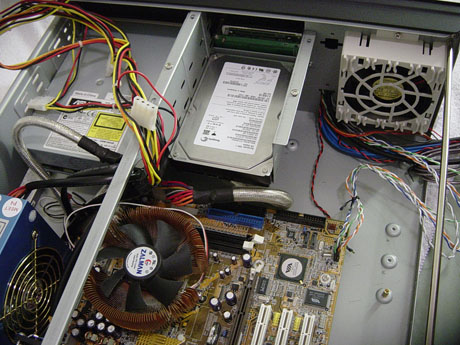SilverStone Lascala 10M: An Exclusive Look at SilverStone's Newest Creation
by Purav Sanghani on November 13, 2004 8:26 AM EST- Posted in
- Cases/Cooling/PSUs
Installation
The LC10M is as large as the Ahanix D.Vine 4. There is a lot of space to install all of the components, including the power supply, motherboard, disk drives, and expansion cards. The total time that it took us to install all of those components was about 15 minutes.We had some trouble with the motherboard's power connector; it was directly beneath the 5-1/4" drive bays and had a clearance of a little over an inch. Those of us who know power supply wiring will also know how difficult it is to work in cramped cases.
The wiring had to be bent at almost 90 degrees for the wiring to be plugged into the power port on the motherboard. We were worried that this might cause damage to the wires, but we had no other choice. In the end, there wasn't much that we could do but warn our readers to choose a board with the power socket placed in another area on the motherboard. ATX motherboards usually have the socket at the top near the CPU socket.
Installation of the other components was straightforward with the exception of the optical drive. We felt that the process of removing the front panel was unnecessary in order to add a single optical drive. The extra drive tray bezel attachment could have also been designed to replace the optical drive's existing tray bezel instead of sticking on to it with double-sided padding. It is a great idea overall, but, in our opinion, it still needs some adjustments in design.












8 Comments
View All Comments
Larry Chanin - Friday, December 24, 2004 - link
To follow-up on the last suggestion. I'm a home theater enthusiast and I know absolutely nothing about building HTPC's. So I found reading your reviews of HTPC cases extremely helpful. However, I have to admit I was totally shocked by the measured sound levels of both cases reviewed. In my home theater the projector measures about 27 db. Therefore HTPC's measuring in the 40's and 50's would be totally unacceptable. With the addition of noise-reducing products could one reasonably expect to quiet these HTPC's down to db sound levels in the 20's, or am I wasting my time researching building an HTPC?i6hlf - Tuesday, November 16, 2004 - link
Speaking of loud HTPC's, why doesn't Anandtech dig into the design of a silent and cool HTPC. I mean some solutions with laptop cpu, mob and cooler system must be an obvious solution…Tarumam - Monday, November 15, 2004 - link
A good looking desktop case for a change. But why would I ever want a loud HTPC? Sounds like an oxymoron to me.ImJacksAmygdala - Sunday, November 14, 2004 - link
Anandtech does a great job with HTPC case reviews. The thermal mapping, sound levels, and wire bundle/heatsink clearance is exactly what the HTPC crowd wants to know.As for the value memory review eetnoyer mentioned, ya I'd love to see that to although only Anandtech does HTPC case reviews right.
Besides if they showed benchmarks of value RAM overclocking just fine with AMD64 +3200 it might effect their sponsor's enthusiast memory line sales...
Gatak - Sunday, November 14, 2004 - link
I really like the thermal display over different areas of the case. Great thing to see where the hot spots arise. =)Degrador - Saturday, November 13, 2004 - link
Just thought I'd say I love the new thermal benchmarking stuff - gives a great indication of where the dead zones are (although seemingly none in this case).phaxmohdem - Saturday, November 13, 2004 - link
My first thought... Alienware MPC?http://www.alienware.com/product_detail_pages/DHS_...
eetnoyer - Saturday, November 13, 2004 - link
Instead of media PC cases, how about that mainstream (value) memory review that was promised a couple of months ago. I think it would have a much broader appeal to your readers. Not bashing, I've just been waiting with baited breath.